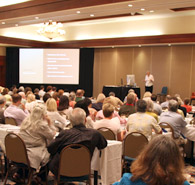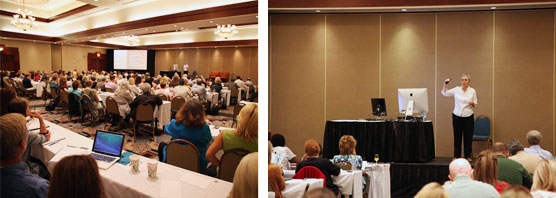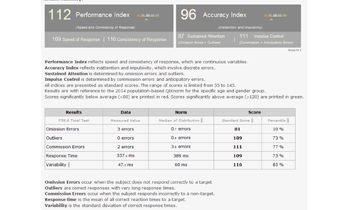Synchrony Training at the 2014 Clinical Summit
by Siegfried Othmer | August 20th, 2014by Siegfried Othmer, PhD

T he 2014 Clinical Summit was held July 10th, 11th, and 12th here in Los Angeles at the Woodland Hills Hilton, right next door to our office and training facility. It was our largest turnout yet, with 140 people in attendance. The location allowed us to utilize our office for all of the practicum sessions that were offered to attendees, for the purpose of evaluating the new programs. A number of distinguished guest speakers contributed expertise in specialized areas, and the feedback we have received so far has been glowing. We are so thankful to everyone who made the effort to be present this year, and grateful to once again be in the position to share the latest developments in the field with our network of committed neurofeedback practitioners.

Synchrony Training
The theme of the 2014 Clinical Summit was synchrony training, which provided the opportune moment for us to introduce Dr. Les Fehmi to our practitioner community as our featured speaker. Dr. Fehmi first encountered synchrony training in the late 1960s, and has since been sharing his extensive knowledge and experience with individuals and couples. He is currently the director of the Princeton Biofeedback Centre in Princeton, New Jersey, where he has worked and taught for his entire career.
We have been nibbling at the edges of this type of approach with two-channel Alpha-Theta training, which also weights the phase relationship between the two channels into the reward. But in the manner that Dr. Fehmi has been conducting the work, the process is really very different, and the objectives are as well. Whereas in Alpha-Theta training the purpose is largely to effect psychological resolution of prior traumas, to loosen the grip of bad habits and dependencies, and to allow the person access to his core self, in alpha synchrony training the objective is to enhance the quality of awareness and to enlarge our repertoire of modes of attention.
In both cases, the emphasis is on those aspects of the process that impinge on consciousness, and on those with which we can engage volitionally. In synchrony training, more so than in Alpha-Theta, there is also the brain training aspect that hopefully bears fruit over the long-term. The brain is cued toward calm states even while the person maintains a fully alert and attentive state. This pairing of calming with alertness is not unfamiliar to us, of course, since the same happens with infra-low frequency training. But essential differences remain that make it desirable to offer both training options to the client.
In infra-low frequency training, the priority lies unquestionably with right-hemisphere training that takes us to the foundations of our developmental hierarchy. The primary linkage being addressed is the coupling of arousal regulation with affect regulation (and by extension, autonomic regulation). The calming that clients report is the visceral confirmation of movement toward better regulation of affect and hence of arousal. What, then, is different in the case of alpha synchrony training? In this case, the primary linkage being addressed is the coupling of arousal and the attentional system. This sits higher in the hierarchy of regulation and therefore represents a natural complement to the infra-low frequency training.
The infra-low frequency training accomplishes its purposes in a manner that remains largely mysterious to the client. All they end up knowing is that “if we train A, then function D improves.” And matters proceed from there. In synchrony training the same thing occurs, but there is the additional possibility of conscious involvement with the process; so much so that a natural pairing has developed in Dr. Fehmi’s work between the instrumentally-aided brain training and the technique called “Open Focus”®, in which specific exercises are conducted in order to facilitate the same processes that are favored in the synchrony training.
As mastery is progressively achieved, the weight falls increasingly on the practice of Open Focus to take things further, and the client relies less on the instrumental support of the process. It is therefore recommended that practitioners who take up the synchrony training for their clients also acquaint themselves with the Open Focus techniques. The best entry portal for this is the book by Dr. Fehmi and Jim Robbins titled The Open Focus Brain. This book has sold 27,000 copies in English, and has been translated into six other languages. The German language printing has even sold out.
Two-Channel Difference Training
Another marquee feature of the Clinical Summit was the introduction of two-channel difference training into the infra-low frequency protocols by Sue Othmer. This gives us access to the common-mode component of the two signals, which is the most important aspect for the purposes of inhibit training. The strengthening of the inhibit component of the protocol has been amazingly effective in improving the overall training experience. The mystery is why that should be the case. It may well be that a certain synergy exists between the two aspects of the protocol.
For quite some time now I have been intrigued by the supposition that the infra-low frequency training places the nervous system in a state that is most receptive to other cues such as the inhibits, and in the most propitious condition to act upon them. That is to say, the learning of state regulation is facilitated by residence in the calmest, best-regulated, and least engaged state of which the system is capable at that moment, and ILF training takes us there.
Two-channel difference training has actually been part of Cygnet off-and-on over the years. There has been a reluctance to move beyond the elegant simplicity of single-channel training, so this capability was never prominently featured in our training. With the new front end of the NeuroAmp II, however, it is possible now to implement the two-channel difference mode of training with only three electrodes. With that simplification, we had every reason to push on with the exploitation of two-channel difference training.
Two-Channel Synchrony for Cygnet
Sue Othmer also introduced the new two-channel synchrony training module for Cygnet, which has been under development over the past year. This is a design evolution from the prior two-channel sum training that has been in existence for some time. This has been our closest approximation to the kind of training that Dr. Fehmi has been promoting, but without the explicit focus on the alpha band. The feedback on the sum signal is still in place as before, but now an additional reward is layered on top whenever the synchrony criterion is met. The visual feedback provided specifically for the synchrony module consists mainly of several fractals that slowly evolve over time, and pastoral scenes are also available.
As was mentioned above, two-channel synchrony training can be implemented with only three electrodes on the scalp. Since all placements are referential, one simply utilizes a linked connection for both references and the amplifier common, also referred to as the ground. This is conveniently implemented with two jumper cables at the amplifier, with only one lead going to the head to serve as both reference and common.
[Watch Tech Tip Video on Using Jumper Cables]
In her main talk, Sue also presented data on the distribution of optimal frequencies that have been observed for the two key starting protocols, and for the principal categories of cases. The findings tend to confirm the appropriateness of our starting values for the beginning of the optimization procedure. A perspective was also given on how we see all the protocol pieces fitting together into an overall clinical strategy. Synchrony training has been the missing piece. With this addition, there are now three two-channel training options for Cygnet: Alpha-Theta, Synchrony, and Infra-low Frequency HD. Sue’s guide to all three training options can be found here: 2 Channel Neurofeedback User Guide
Couples Training
We invited Dr. Jerry Wesch to present on couples training. Jerry Wesch is Director of the Combat Stress Reset Program at the US Army Medical Center in Fort Hood, Texas. He has been using a variety of conventional and unconventional methods in the recovery from PTSD and TBI in returning soldiers, including neurofeedback using Cygnet. He has been active in the field of alpha training since the early days, and in fact was instrumental in the making of Dr. Fehmi’s first demonstration tapes for Open Focus training.
Couples training is a natural extension of the two-channel sum training, and has already been in use in that form by a number of clinicians in the network. The two trainees each train on one channel, and the clinician merely has to assure that they are both at a common ground potential. Each is rewarded on their own alpha amplitudes, and additionally on the sum of the two channels. Prescribing matched phases in this case would be inappropriate. After all, the two people may not even have the same alpha dominant frequency, so there is no expectation of phase synchrony.
Interpersonal synchrony is facilitated by the existence of an affective bond, but it is not required. In his presentation, Kurt Othmer talked about EEG measurements on a dozen pairs of guitarists, finding that EEG synchrony emerged within the pairs even before they began to play. There is a propensity toward EEG synchrony when two people are in close collaboration, even absent an affective bond or the synchronizing effect of the musical performance itself.
Jim Robbins
We invited Jim Robbins to attend as a natural complement to having Les Fehmi here. His enthusiasm for neurofeedback is partially accounted for by the fact that he seems to have had an observably positive experience with every kind of neurofeedback training that he has ever tried, starting out with our own SMR/beta training in the early nineties. As with so many others, it was direct personal benefit from the training that drew him in.
Jim yielded some of the time in his talk to allow Dr. Fehmi to demonstrate pain abatement with his Open Focus exercises. A number of folks in the audience were invited to demonstrate the technique one after another. It was indeed an impressive demonstration of the central role of the brain in the pain experience. With increasing EEG synchrony, the brain moves toward de-objectification. In the pain experience, pain is intended to assert itself as a priority in our experience, and yet in the case of chronic pain this is no longer useful. The de-objectification strategy can diminish the rank of pain in the immediate experience even to the point of insignificance. One assumes that those who demonstrated their mastery of pain on this occasion had not done a lot of alpha synchrony training beforehand, so it appears that this capacity for pain management is merely enhanced by explicit practice in alpha synchrony, rather than being contingent on it.
Professional Issues
Scope of Practice issues and related issues of professional risk were discussed by Michael H. Cohen of the Michael H. Cohen Law Group. This presentation was recorded, and after some light editing will be made available for free to the entire biofeedback and neurofeedback community.
Nutritional Issues with Hyla Cass, MD
Dr. Hyla Cass was invited to speak on issues regarding health and nutrition. We are now headed toward an era of integrative medicine, albeit fitfully. One key step along the way is the realization that clinical conditions such as anxiety, depression, and substance dependency can be usefully aided with non-medical remedies, in particular nutrition. From our perspective, we see the thrust toward integrative medicine being fleshed out almost exclusively within the biomedical model, even though vague concepts such as “energy medicine” are often tossed about as well. This is at best a non-committal genuflection before a reality that cannot yet be grasped. Meanwhile, progress on the biomedical side is there for us to utilize, even while our own competences still fail to be acknowledged or understood. In this exploratory phase, and given the multidisciplinary character of integrative medicine, progress must be made empirically. This is our turf indeed.
The Norming Project for the QIKtest
The Norming Project was the subject of my presentation on the final day of the Summit. The case was made for the use of population-based norms, even one that was composed almost entirely of people seeking neurofeedback services. The case was also made for the use of non-parametric analysis in terms of percentiles rather than standard scores based on a Gaussian model. Results were then presented for the pre-post analysis of some 5,000 cases in the EEG Expert database using the new norms. To facilitate inspection of the results, the percentile scores were converted into their standard score equivalents. This rendered the distributions to be nearly Gaussian, which put the viewer back on familiar turf.

EEG Expert Manual [PDF Manual]
Report from EEG Info
Kurt announced that we will be conducting an efficacy study on a new device, the SomniResonance, which aids sleep onset, for purposes of gaining FDA approval. Some fifty network practitioners have been recruited into this effort, and each will be conducting trials with two individuals for two weeks each. We have been working with the manufacturer of this device for a number of years, and have high expectations that the SomniResonance will fill a niche for us in our work with sleep disorders.
In earlier trials of similar technology, conducted with Parkinson’s patients and with Multiple Sclerosis patients, we had great difficulty in retrieving the devices from the participants after the trial, as was required. This already testified to their efficacy.
Summary
It is difficult to convey in a newsletter the energy that is generated within a practitioner community at an event such as our Clinical Summit. We have evolved a technique that simply must be experienced to be managed, and it confronts a profession that disregards experience as a path to knowledge. Events like this year’s Summit are significant milestones in the development of the field as a whole. Opportunities to share our experience and expertise with each other can be hard to find, considering how widely arrayed, and dispersed, neurofeedback practitioners are.
The sense of community and shared learning is one we relish, and look forward to facilitating again in 2015.





